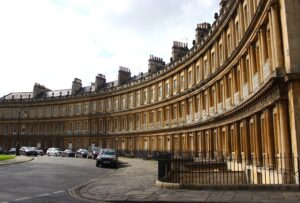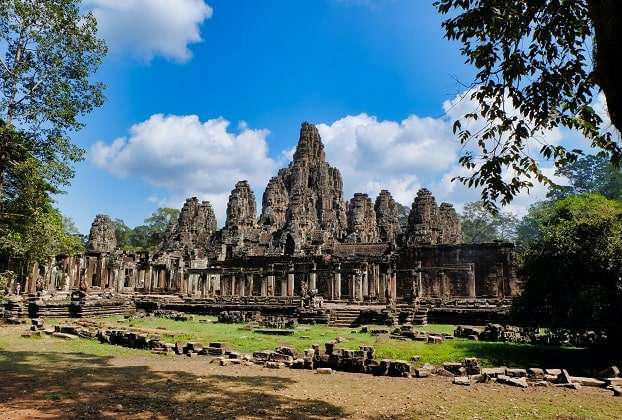
Angkor is the capital city of the Khmer Empire also known as Yasodharapura. Angkor Thom is a walled city made to protect the kingdom. Among the all temples, Angkor Wat is the most prized one inside the complex.
Wat’s is the connection between India and Cambodia
Before beginning, I would like to tell you that there is no spelling mistake in the question above.
So, does it make sense?
Yes, it does!
The answer lies in the question itself.
Wat is the connection between India and Cambodia?
Confused?
Okay, so let me satiate your curiosity.
Angkor Wat is the connection between India and Cambodia.
What is Wat?
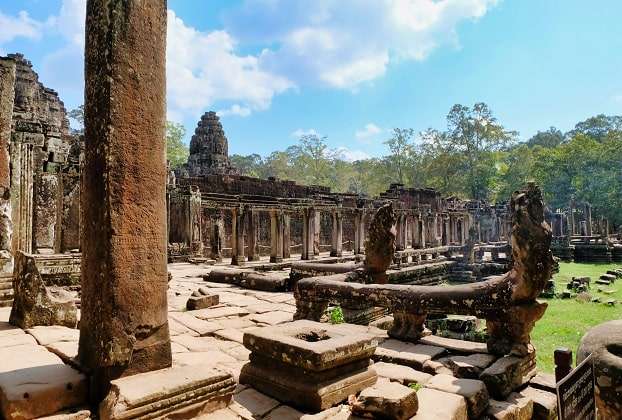
Angkor is the capital city of the Khmer Empire also known as Yasodharapura. Angkor Thom is a walled city made to protect the kingdom. Among the all temples, Angkor Wat is the most prized one inside the complex.
It is spread over an area of around 402 acres which is more than the size of Paris and it has more stones than any Egyptian pyramid. After 500 years this place failed and faced the wrath of nature and subsequent attacks as a result of which the people fled and since then it has been abandoned.
Angkor or Nokor?
The term Angkor is actually “Nokor” derived from the Sanskrit word “Nagar” meaning city but due to incorrect pronunciation it is called “Angkor”.
Angkor Thom, “as fantastic as the Atlantis of Plato”
Deep in the forests of Cambodia’s Siem Reap province, an ancient city soars towards the sky. The site is located in the Northwestern region of the country. The Khmer Empire lived and ruled here from the 9th to the 15th century. This kingdom is spread over from Myanmar to Champa (Central Vietnam).
Devaraja or the God King
The Khmer kings were all Shaivaites (worshippers of Shiva). The king was called “Devaraja” (God King). Jayavarman VII took on the title of “Chakravartin” meaning the Universal King. There are various Hindu temples and Ashramas inside the complex. Angkor Thom or Nokor Thom was the last capital city of this empire established by King Jayavarman VII.
Other Capital cities at different times
Earlier there were many other capital cities with the change of kings such as Kambuja, Mahendraparvata, Hariharalaya, Yasodharapura etc. Indrapura was the first capital city taken on by King Jayavarman II, who declared “Kambujadesa” an independent kingdom separated from Java.
The decline of the Khmer Kingdom
The decline of the kingdom started between the 13th and 15th centuries with the natural disasters and the ongoing invasions by the rulers of Ayutthaya or Ayudhya (Phra Nakhon Si Ayutthaya in present-day Thailand).
Origin of the term Angkor Wat from Sanskrit
Angkor Wat means “City of Temples”. Angkor means “city/capital city” taken from the Sanskrit word “Nagara” meaning city. Wat means “temple” which is also taken from the Sanskrit “Vaata” meaning “yard”. The temple was originally known as the “Varah Vishnu Loka/Parama Vishnu Loka” which refers to the sacred abode of Vishnu.
The largest Hindu Temple in the world
It is the largest Hindu temple in the world measuring more than 402 acres dedicated to Lord Vishnu.
The construction was started by King Suryavarman II and finished by King Jayavarman VII. It was constructed as a state temple and a mausoleum for the king.
The walls of the Angkor Wat temple portray Hindu cosmology and the outer walls are shaped like mountains denying the outer world entrance to the complex. The temple is in the shape of Mount Meru which is the home of the Gods in Hinduism.
India’s role in the present-day restoration project:-
“Today when we are restoring, rebuilding, and re-energising Indian civilisation, our task is not only in India. Our task is all over the world.”- S Jaishankar#angkorwat #National #Jaishankar
— Odisha Shines (@odisha_shines) December 16, 2022
Follow @odisha_shines pic.twitter.com/YcBzQ86rvQ
The first country to carry out the restoration and conservation of the temple complex was France which started in the year 1908. The Archaeological Survey of India (ASI) started out a restoration programme in the temple complex from 1986-1992.
In the year 1994, APSARA was established by the Cambodian government to protect and preserve the site. Since then, various countries including Germany, France, India, Japan and China have joined hands in the protection, preservation and restoration of this temple.
How has Covid-19 affected this wonder?
In the pre-covid times till the year 2019, about 7,000 tickets were sold on a daily basis. But in the post-covid times, tourism has declined and in February 2022 about 250 tickets were sold in a day this place has worked its wonders with a sale of 56,842 Angkor Wat tickets in November 2022. In November 2021 only 2,202 tickets were sold.
How to reach Angkor Wat?
• The town of Siem Reap is the gateway to Angkor and is filled with lodging, dining and tour package options for all budgets. The airport in Siem Reap has service to the capital and regular flights to nearby countries.
One can reach Angkor through Siem Reap City by taking a bus or tuk-tuk (e-rickshaw).
• Those preferring to travel by boat can also make the trip from Phenom Phen in 5-6 hours about the same time as by road.
Timings:-
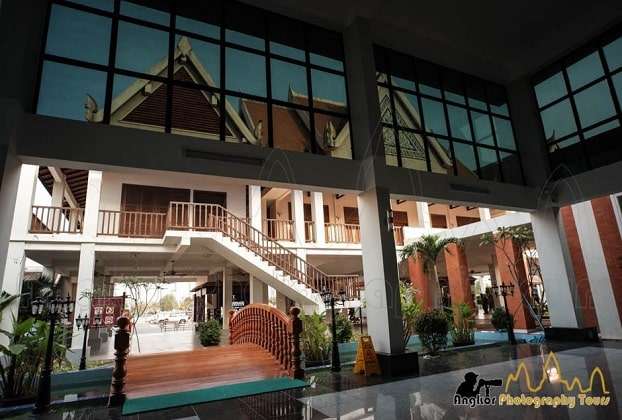
- Angkor : 07:30 a.m to 05:30 p.m
- Angkor Wat temple : 05 a.m to 05:30 p.m
- Angkor Archaeological Park: 05 a.m to 07 a.m
- Sras Srang water reservoir: 05 a.m to 05:30 p.m
- Pre Rup : 05 a.m to 07 p.m
- Phnom Bakheng temples : 05 a.m to 07 p.m
- All the sites are open on all days of the week.
Entry tickets:-
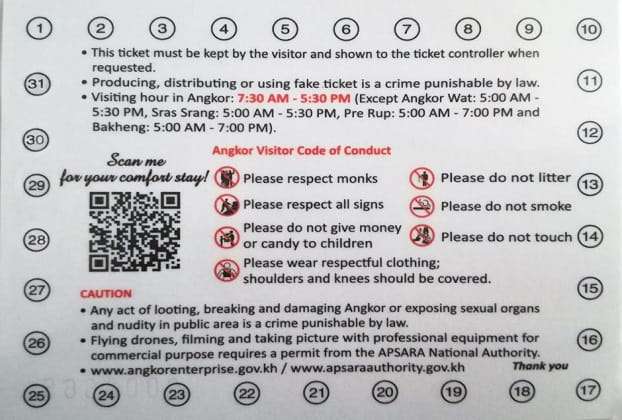
- 1 day: $37 (valid for 2 entries during a period of 5 days)
- 3 days: $62 (valid for 5 entries during a period of 10 days)
- 7 days: $72 (valid for 10 entries during a period of 30 days)
- Children below the age of 12 are allowed free entry.
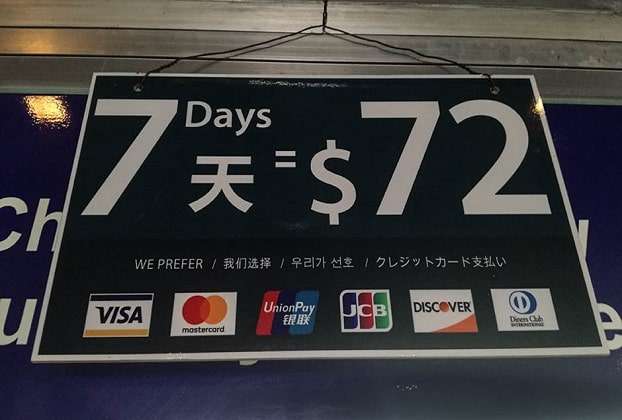
There is a special entry pass for long-time residents with valid visas (minimum 3 months) :
- 6 months: $200 (+6 months for free)
- 3 months: $150 (+3 months for free)
- 1 month: $100 (+1 month for free)
- This offer is ongoing and is valid until 31st December 2022.
Best time to visit Angkor Wat:-
Peak tourist season in Angkor is December and January when rainfall is less likely and the weather is most suitable and kind. Visiting at sunrise is the perfect time to watch this beautiful wonder.
No matter what time of the year a visit to Angkor is sure to leave you awestruck. So make sure to add this magnificent place to your foreign travel lists.
FAQs:-
1. Who Built Angkor Wat?
Ans – The construction was started by King Suryavarman II and finished by King Jayavarman VII. It was constructed as a state temple and a mausoleum for the king.
2. What happened to Angkor Wat?
Ans – The decline of the kingdom started between the 13th to the 15th century with the natural disasters and the ongoing invasions by the rulers of Ayutthaya or Ayudhya (Phra Nakhon Si Ayutthaya in present-day Thailand).
3. In which country is Angkor Wat located?
Ans – Angkor Wat was built as a Hindu Temple in northern Cambodia between the 13th to 15th centuries.
4. What is the ticket booking process for Angkor Wat? Offline and Online Process:
- There are 48 ticket counters; most of them are for the 1 and 3 days pass and only one of them is for the 7 days pass.
- There is a long queue for tickets mostly before 5 a.m and generally one has to wait for 5 to 25 minutes to buy the tickets depending on the time of the day.
- In March 2018, a new e-ticketing platform has been created which saves time.
- Children under the age of 12 need to present their passports to avail of free tickets.
- The tickets are non-transferable.
- If booking tickets offline, you need to be physically present as an ID picture will be taken with a webcam at the counter.
- Only buy the tickets from the official website i.e., angkorenterprise.gov.kh.
Also, read about Unakoti: Also known as the Angkor Wat of the Northeast.

